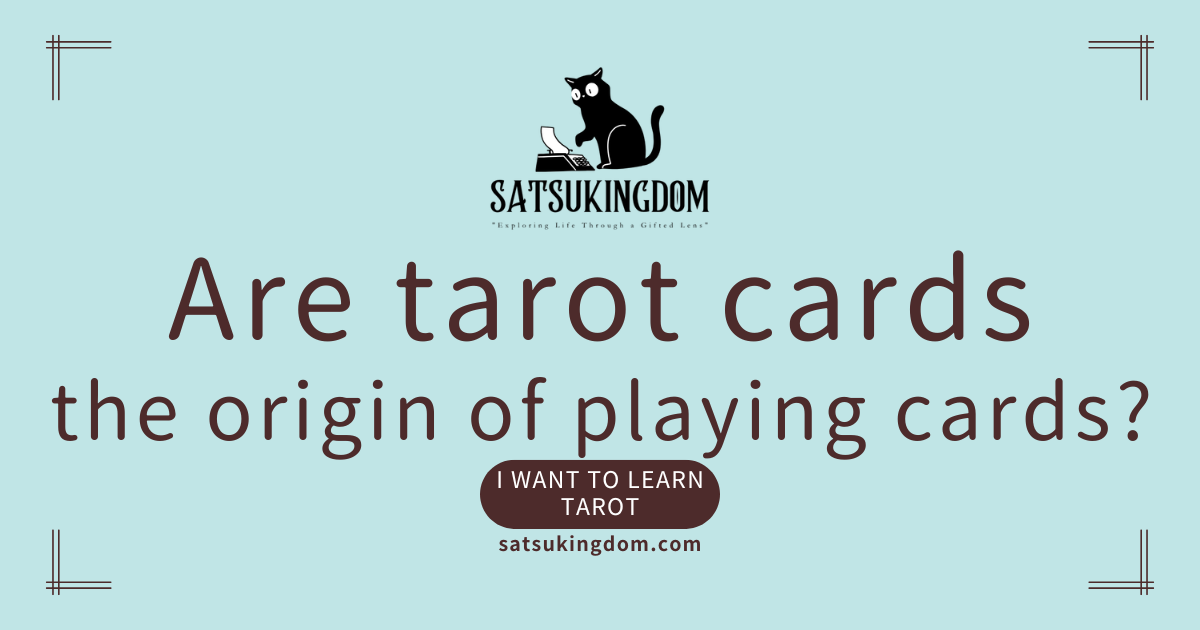This time, I’ll be discussing the theory I encountered while studying tarot cards: that tarot cards are the origin of playing cards.
Common Features of Tarot Cards and Playing Cards
Tarot cards consist of 22 Major Arcana and 56 Minor Arcana. Of these, the 56 Minor Arcana are considered the origin of playing cards.
Suit (mark)
The Minor Arcana is divided into the following four suits.
- Wands
Staves or clubs, symbolizing the element of fire. - Cups
Goblets or chalices, symbolizing the element of water. - Swords
Swords, symbolizing the element of air. - Pentacles or Coins
Coins or five-pointed stars, symbolizing the element of earth.
These four suits are thought to correspond to the suits in playing cards. Each is believed to symbolize neutral European social classes or elements.
- Wand (Club) ⇔ Clubs
→ Workers and peasants - Cup (Chalice) ⇔ Hearts
→ Clergy - Sword ⇔ Spades
→ Nobility and military - Pentacle (Coin) ⇔ Diamonds
→ Merchants
Card Structure
Each suit of the Minor Arcana consists of ten numbered cards from 1 to 10 and four court cards (person cards): Page, Knight, Queen, and King, totaling fourteen cards.
Playing cards consist of ten numbered cards from Ace (1) to 10, plus three face cards: Jack, Queen, and King, totaling 13 cards.
This difference in composition is thought to stem from the Knight card being lost or merged into the Jack in order to account for the evolution of playing cards from the Minor Arcana. Additionally, there is a theory that the Joker originates from “The Fool” found in the Major Arcana of the Tarot.
Historical Background
There are various theories about when and where tarot cards originated, but the most widely accepted one places their beginnings in northern Italy during the first half of the 15th century. Initially, they were not used for divination but rather as playing cards enjoyed by the nobility. Records exist of a card game similar to tarot, known as a “trick-taking game,” where the Major Arcana were used as trump cards.
As this game spread across Europe, particularly gaining popularity among commoners in France, it evolved into simpler, more portable playing cards. During this process, the Minor Arcana became independent, eventually evolving into modern playing cards.
It’s quite intriguing that tarot, now used as a tool for divination, began as a tool for games. One might imagine the cards diverged into playing cards for their convenience and tarot for their mystique.
There are various theories.
It’s common for historical accounts to have multiple theories.
Based on similarities in structure and suits, I find this theory quite convincing. However, it seems there are also various theories about the origins of tarot itself, and this theory doesn’t appear to be proven as absolute fact either. After all, we’re talking about hundreds of years ago. In Japan, that would be around the Muromachi period. There’s also a completely opposite theory suggesting playing cards existed first, and tarot was created by adding the special Major Arcana cards to make it more complex.
Indeed, I recall friends using playing cards for fortune-telling back in elementary school. Perhaps another pattern emerged where, as playing cards were increasingly used for divination, special illustrated cards convenient for fortune-telling gradually multiplied.
Personally, I find the flow more natural: tarot cards were enjoyed as a game among nobility, and later, simplified versions spread among commoners, evolving into playing cards. I’ll cast my vote for that theory.
For now, I’ll conclude that the Minor Arcana seems to be the origin of playing cards. But perhaps history’s very uncertainty is what gives it its romance. Tarot cards dating back to the Muromachi period are amazing. They’re still actively used for divination, much like Japan’s Hyakunin Isshu (c. 1235).
As a side note, the divination practice using the Hyakunin Isshu, called “uta-ura” (song divination), is said to be the origin of the waka poems written on shrine omikuji fortune slips. Oh, there are various theories, though.



コメント